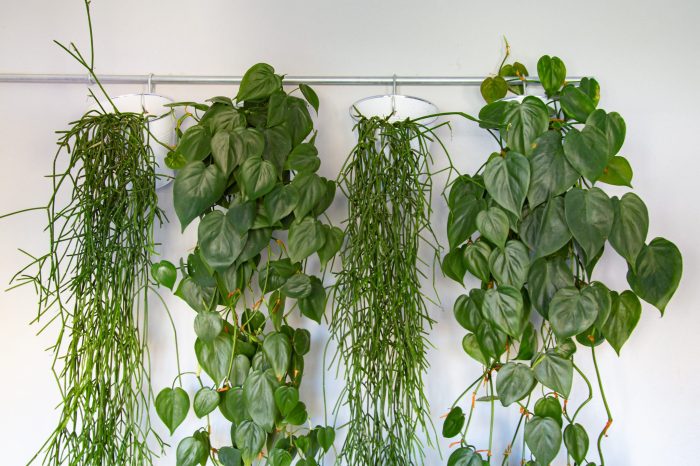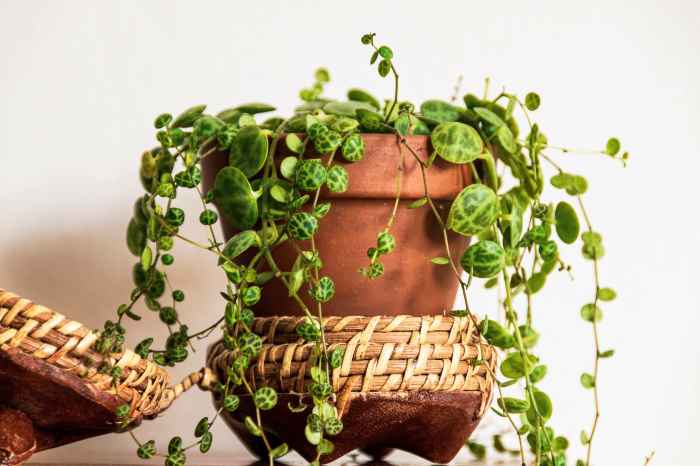Real trailing plants indoor are a versatile and captivating addition to any home, offering a touch of nature, improving air quality, and reducing stress. With their unique growth habits and diverse characteristics, these plants add a dynamic element to indoor spaces, creating a sense of tranquility and visual interest.
From the cascading tendrils of pothos to the delicate fronds of ferns, trailing plants come in a wide variety of shapes, sizes, and colors. Their adaptability makes them suitable for various indoor environments, from bright and airy living rooms to cozy and dimly lit bedrooms.
Popular Trailing Indoor Plants

Trailing indoor plants are a beautiful and versatile way to add life and greenery to your home. They are perfect for hanging baskets, shelves, or windowsills, and their long, trailing stems can create a dramatic effect.There are many different types of trailing indoor plants to choose from, each with its own unique characteristics.
Some of the most popular varieties include:
Spider Plant
- Botanical name: Chlorophytum comosum
- Characteristics: Long, thin leaves with variegated green and white stripes; produces small white flowers and plantlets on long stems
Pothos
- Botanical name: Epipremnum aureum
- Characteristics: Heart-shaped leaves that come in a variety of colors, including green, yellow, and white; easy to care for and can tolerate low light
English Ivy
- Botanical name: Hedera helix
- Characteristics: Small, lobed leaves that come in a variety of colors, including green, yellow, and white; can be invasive, so it is important to keep it trimmed
String of Pearls
- Botanical name: Senecio rowleyanus
- Characteristics: Long, trailing stems with small, round leaves that resemble pearls; can be difficult to care for, but is a beautiful and unique plant
Burro’s Tail
- Botanical name: Sedum morganianum
- Characteristics: Thick, fleshy leaves that resemble a donkey’s tail; can be difficult to care for, but is a beautiful and unusual plant
These are just a few of the many different types of trailing indoor plants that are available. With so many different varieties to choose from, you are sure to find the perfect plant to add life and beauty to your home.
Care Requirements for Trailing Plants
Maintaining the health and beauty of trailing indoor plants requires specific care considerations. Understanding their unique needs for lighting, watering, and fertilization is essential for ensuring their optimal growth and appearance.
To create a thriving environment for trailing plants, it is crucial to provide them with the right amount of light. Most varieties prefer bright, indirect light, which can be achieved by placing them near a window that receives plenty of natural light without exposing them to direct sunlight.
Avoid placing them in areas with low light, as this can hinder their growth and lead to leggy, weak stems.
Watering
Watering trailing plants requires a delicate balance to prevent overwatering or underwatering. Allow the soil to dry out slightly between waterings, as soggy soil can lead to root rot. Use room-temperature water and avoid getting the foliage wet, as this can promote fungal diseases.
During the growing season, water more frequently, reducing watering in the fall and winter when growth slows down.
Real trailing plants indoor add a touch of nature and elegance to any space. Trailing plants are a popular choice for indoor gardening as they are relatively easy to care for and can add a touch of greenery to even the smallest of spaces.
They come in a variety of shapes and sizes, making them perfect for any home or office. Real trailing plants indoor can help to improve air quality and can even boost your mood.
Fertilization, Real trailing plants indoor
Fertilizing trailing plants during the growing season provides essential nutrients for healthy growth. Use a balanced liquid fertilizer diluted to half strength and apply it every two to four weeks. Avoid over-fertilizing, as this can burn the roots and damage the plant.
Suspend fertilization during the dormant winter months.
Decorative Uses of Trailing Plants: Real Trailing Plants Indoor

Trailing plants, with their cascading foliage and graceful tendrils, offer a versatile decorative element for indoor spaces. Their ability to drape over shelves, hang from baskets, or cascade down walls adds a touch of greenery and visual interest to any room.
Incorporate trailing plants into your indoor décor to achieve a range of styles, from bohemian to contemporary. Their adaptability allows for creative placement, whether in a hanging planter above a window, trailing down a bookshelf, or adding a splash of color to a corner.
Vertical Accents
Utilize trailing plants to create vertical accents in your living space. Suspend them from ceiling hooks or macrame hangers to draw the eye upward and create a sense of height. This is especially effective in rooms with high ceilings or limited floor space.
Trailing plants like pothos, ivy, and string of pearls lend themselves well to vertical arrangements. Their long, flowing stems cascade gracefully, adding a touch of greenery and movement to your décor.
For those looking to add a touch of greenery to their indoor space, real trailing plants are a popular choice. These plants can be used to create a lush, cascading effect, adding a touch of nature to any room. To maximize the impact of trailing plants, consider using wall plant pots indoor . These pots allow plants to hang vertically, creating a dramatic and eye-catching display.
By combining trailing plants with wall plant pots, you can create a stunning indoor oasis that will bring a sense of tranquility and beauty to your home.
Shelf Decor
Adorn your shelves with trailing plants to add a touch of nature to your storage solutions. Place them on the edges of shelves to create a cascading effect, or let their tendrils drape over the sides for a more whimsical look.
Trailing plants such as spider plants, succulents, and ferns are ideal for shelf decor. Their compact size and ability to tolerate low light make them suitable for most shelf arrangements.
Wall Decor
Create a living wall by mounting trailing plants on a wall-mounted trellis or frame. This technique adds a touch of greenery to bare walls and transforms them into vibrant focal points.
Use trailing plants like creeping fig, philodendron, or heartleaf philodendron for wall decor. Their ability to cling to surfaces makes them ideal for creating vertical gardens indoors.
Tabletop Centerpieces
Incorporate trailing plants into your tabletop arrangements to add a touch of elegance and greenery. Place them in hanging planters or on elevated stands to create a cascading centerpiece that draws attention to your dining table or coffee table.
Trailing plants like maidenhair fern, peperomia, or pilea are suitable for tabletop centerpieces. Their delicate foliage and compact size add a touch of sophistication to any gathering.
Benefits of Trailing Plants
Trailing plants offer numerous benefits, not only enhancing the aesthetics of indoor spaces but also providing health and well-being advantages.
Scientific studies have shown that trailing plants can significantly improve air quality by removing harmful toxins and pollutants. For example, a NASA study found that spider plants (Chlorophytum comosum) effectively remove formaldehyde and carbon monoxide from the air.
Stress Reduction
The presence of trailing plants in indoor environments has been linked to reduced stress levels. Research conducted by the University of Exeter in the United Kingdom revealed that exposure to indoor plants, including trailing varieties, can significantly decrease physiological and psychological stress.
Connection with Nature
Trailing plants bring a touch of nature into indoor living spaces, creating a sense of tranquility and connection with the natural world. Studies have shown that interacting with plants can promote positive emotions, reduce feelings of loneliness, and enhance overall well-being.
DIY Projects with Trailing Plants
Incorporating trailing plants into your indoor decor not only adds a touch of greenery but also provides opportunities for creative DIY projects. Here are four unique ways to utilize trailing plants to enhance your home’s aesthetics:
Hanging Plant Wall
- Materials:Trailing plants (such as pothos, philodendron, or ivy), macrame cord, hooks
- Steps:
- Cut macrame cord to desired lengths and attach to hooks on the wall.
- Create knots to form plant holders.
- Insert trailing plants into the holders and adjust the height as needed.
- Image:[Insert image of a hanging plant wall with trailing plants]
Macrame Plant Hanger
- Materials:Trailing plants, macrame cord, scissors
- Steps:
- Cut macrame cord into four equal lengths.
- Tie the cords together at the top and create a loop for hanging.
- Divide the cords into pairs and tie square knots along the length.
- Insert the trailing plant into the bottom of the hanger and adjust the length as needed.
- Image:[Insert image of a macrame plant hanger with a trailing plant]
Trailing Plant Terrarium
- Materials:Trailing plants (such as ferns, mosses, or peperomias), glass terrarium, activated charcoal, potting mix
- Steps:
- Line the bottom of the terrarium with a layer of activated charcoal.
- Add a layer of potting mix and make a small hole in the center.
- Insert the trailing plant into the hole and fill the terrarium with more potting mix.
- Mist the plants lightly and cover the terrarium with a lid or plastic wrap.
- Image:[Insert image of a trailing plant terrarium]
Trailing Plant Trellis
- Materials:Trailing plants, trellis, wire or twine, scissors
- Steps:
- Attach the trellis to a wall or window frame.
- Use wire or twine to secure the trailing plants to the trellis.
- Train the plants to grow up the trellis by gently guiding their stems.
- Trim any excess growth to maintain the desired shape.
- Image:[Insert image of a trailing plant trellis]
Summary

Whether you’re a seasoned plant enthusiast or a novice gardener, real trailing plants indoor offer a rewarding and enjoyable experience. Their versatility, ease of care, and aesthetic appeal make them an excellent choice for adding a touch of greenery and tranquility to your living space.
So, embrace the beauty of nature indoors and explore the world of real trailing plants. Let their cascading foliage and graceful forms bring a sense of peace, vitality, and style to your home.
Popular Questions
What are the most popular real trailing plants indoor?
Some of the most popular real trailing plants indoor include pothos, philodendron, spider plant, English ivy, and ferns.
How often should I water real trailing plants indoor?
The watering frequency for real trailing plants indoor depends on the specific plant and its environment. Generally, allow the top inch or two of soil to dry out before watering.
Do real trailing plants indoor need a lot of light?
While some real trailing plants indoor tolerate low light conditions, most prefer bright indirect light. Avoid placing them in direct sunlight, as this can scorch their leaves.
What are the benefits of having real trailing plants indoor?
Real trailing plants indoor offer numerous benefits, including improving air quality, reducing stress, adding a touch of nature to living spaces, and boosting mood.